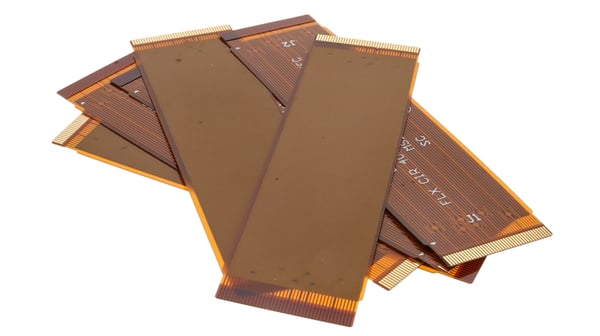When ordering flex circuit boards online, quick turn order delivery timelines can incur setbacks if the data set is either incomplete or if the design has technical issues. Technical issues can be related to either manufacturability or the end use of the parts. These issues then often require multiple communications to resolve and in some worst-case scenarios, extensive design revision. Any of these issues will of course delay the delivery of the finished parts.
In this post we will detail some of the more common flex circuit technical issues we often see that delay quick turn orders to help you avoid delays and complete assembly and delivery of your product as quickly as possible.

Custom manufactured flexible circuit boards.
Incomplete Data Sets
Submitting incomplete data sets with your file designs is a leading cause of quick turn delays. Flexible PCB data sets should contain a full set of Gerber files, a mechanical drawing or spec sheet with the required specifications, and a material stack up.
The material stack-up in some cases may be outside of the customer’s scope of knowledge. The critical elements for inclusion are the copper weight requirements and the desired finished thickness necessary to meet a specific bend requirement. From this information, we can propose a material stack-up that will meet the design objectives.
It is preferable to use a thinner copper thickness in order to achieve a more flexible and mechanically reliable part. The most commonly used copper weights are ½ oz and 1 oz if there are higher current carrying requirements.
Bend Requirements
In a lot of faulty flex circuit designs, the mechanical bend requirements are not factored into the design and in some cases may be incorrectly specified to the point of exceeding the physical capabilities of the materials used in the flex circuit.
It is recommended for you to provide information which will give an overview of how the part will be used, where the bends will be located, and the radius of the minimum bends. This will allow for an effective design review that will ensure the finished parts will perform reliably.
Design Issues
While the process of creating the data set is similar to that of a rigid PCB, there are a number of additional design rules that are recommended by the IPC 2223 flex circuit design standard to ensure that the finished parts perform reliably.
The below outlines the common flexible circuit design issues we encounter.
- Unsupported component areas:
- Stiffeners are strongly recommended to rigidize component areas.
- This prevents the part from being bent adjacent to components which can lead to solder joint breakage.
- Bend requirements in component areas:
- Not recommend as may lead to solder joint breakage.
- Not recommend as may lead to solder joint breakage.
- Vias or PTH holes in flex areas:
- Not recommended as they create mechanical stress concentrators when the circuit is bent which may crack the plating within the.
- Not recommended as they create mechanical stress concentrators when the circuit is bent which may crack the plating within the.
- 90-degree trace corners in flex areas:
- Not recommended. May create a mechanical stress concentrator when the circuit is bent, which may lead to breakage.
- If a direction change in is required, it is recommended to use radiused corners.
ZIF Connector Specifications
ZIF contacts not correctly defined in Gerber data and or material stack up. This applies to the contact finger locations/dimensions/spacing, local part outline dimensions, coverlay opening dimensions, and stiffener thickness/dimensions.
All these elements are important to ensure a reliable interconnect between the flex circuit and the ZIF connector. We request that the ZIF connector make, and part number be supplied with the data set so that we can verify the design to the manufacturer’s specifications as part of our design review process.
Additional Design Requirements
It is common in many flex designs to require additional items that are not part of a typical rigid board design.
Common examples include:
- Stiffeners:
- Material (polyimide or FR4), thickness, locations?
- PSA’s (pressure sensitive adhesives):
- Used for attachment purposes within the enclosure.
- Part number, locations, is assembly reflow required?
- EMI / RF Shield Layers:
- One side or two sides, ground interconnect location?
Each of the above has its own unique set of design rules. They need to be correctly defined in the data set and incorporated into the design in a manner that is manufacturable. We recommend having technical discussions early in the design process with engineering to ensure the correct materials are selected and that the finished design will pass the DFM review.
Summary
With delivery of flexible PCB prototypes, it is important to provide a complete, accurate, and error-free data set. An accurate data set will greatly help the manufacturer avoid any delays or potential design changes at the last minute. Having these checks and balances in place before you submit your flex circuit order online will eliminate technical issues that delay quick turn orders.
Key Takeaways
- Incomplete Data Sets Cause Major Delays: Missing Gerber files, mechanical drawings, or material stack-ups are the most common reasons for quick turn flex circuit order setbacks. A full and accurate data package ensures a smooth manufacturing start.
- Bend Requirements Often Overlooked: Many flex designs fail because bend radii or locations exceed material limits. Providing detailed bend information upfront prevents cracking or performance failures.
- Ignoring IPC 2223 Design Rules Leads to Reliability Issues: Common design errors include unsupported component areas, 90-degree trace corners, and vias in flex zones, all of which create mechanical stress and risk of circuit damage.
- Incorrect ZIF Connector Specifications: Not clearly defining ZIF finger dimensions, coverlay openings, or stiffener thickness can lead to poor connector fit and unreliable interconnects.
- Additional Design Elements Require Early Coordination: Items like stiffeners, adhesives, and EMI/RF shielding layers must be clearly specified and reviewed early in the design process to ensure manufacturability and avoid costly last-minute revisions.
















